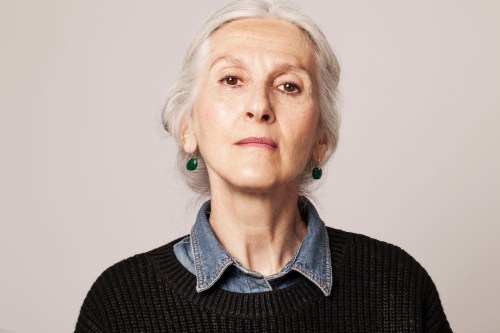Our editors independently select these products. Making a purchase through our links may earn Well+Good a commission
I woke up this morning with two creases between my eyebrows that were so deep, they might as well have been independently memorizing the philosophies of Nietzsche to share at an upcoming dinner party. This state of perma-furrow, thanks to some weird sleeping position I vow to never repeat, left me actually feeling frustrated rather than my everyday situation of just looking frustrated. You see, because I suffer from resting bitch face (RBF), I don’t need additional features or accessories to make me come across as less friendly—with the operative words here being “come across as.” That’s because I’m not actually unfriendly—it’s just, you know, the way my resting face looks. What I wish everyone would realize, though, when parsing answers to the question of what does RBF mean and what does it not is that there are many ways to convey emotions, and not all of them rely on what your face is doing.
Supporting my contention that having RBF really has little if anything to do with actually having the attitude of a B is a recent study by Ohio State University, which points out that facial expressions don’t always show the full spectrum of what a person is feeling. So, what does RBF mean if not conveying a sense that the person sporting the expression is angry, unenthused, and unwelcoming? To help me fight the good fight against RBF stigma, below, a body-language expert explains the demystifies why RBF is received the way it is.
What does RBF mean, according to a body-language pro?
1. RBF is rooted in a smile—but not a great one
“Your face can make over 10,000 different expressions and over 50 different kinds of smiles, and RBF is actually a smile of contempt,” says Patti Wood, body language expert and author of Snap: Making the Most of First Impressions, Body Language, and Charisma. “Contempt is a feeling that a person or thing is beneath consideration, worthless, and deserving of scorn. When someone feels contempt, they often feel superior to others, though people in subordinate power positions can feel contempt to their superiors.”
What this amounts to is a kind-of crooked smile, or even a slight sneer. “What you are seeing is one side of the lip pulled back slightly or a very slight raising the outside corners of the mouth and freezing in place,” she says. “The lack of symmetry of the mouth is seen by others not just as unattractive, but that there is something wrong that is being hidden. It alerts the viewers central nervous system to be on guard and creates a stress response,” says Wood.
2. Neutral or not, RBF still conveys an emotion
“The broader category of ‘resting face’ is the typically neutral expressions a face shows when not actively showing an emotion,” says Wood. “But because your facial expressions actually do move muscles in your face, whatever emotions you show the most may form expressions. Interestingly, it can be the emotion a person believes they are actually suppressing.”
“‘Resting face’ is the neutral expression of not showing an emotion. But because facial expressions move muscles in your face, whatever emotions you show the most may form expressions.” —Patti Wood, body-language expert
So a neutral-seeming RBF might still be showcasing some trace elements of feelings you’ve pushed down in the past. While you might not actually be angry or feel negatively at all, if you’re one to push down feelings of contempt or frustration or sadness, that may be what’s showing. That is, even if your face is relaxed, it still shows traces of emotion. And to take it a step further, the expression might inform what you’re currently feeling. “Think of it as like the lingering effects of a lot of alcohol in your body: You will feel it even if you haven’t had a drink in hours,” Wood says.
3. RBF is interpreted differently based on gender
Men experience RBF at the same rate as women, but when men make the expression, they’re perceived more so as powerful rather than, well…bitchy, Wood says, adding that “smiling differs in males and females.”
4. You can mindfully shift your RBF
“Do resting-face check-ins throughout the day and self-correct,” says Wood. “Look in the mirror in the morning and throughout the day, and check on the cues that show RBF. Change your expression to be what you feel comfortable showing. You don’t have to smile if you don’t want to.” To be clear, that means there’s no need to fake smile, ever.
Trying to stay calm under pressure? Here are some body-language hacks to make you look like the picture of composure. And here’s how to tell if someone is in love with you…based on body language alone.
Sign Up for Our Daily Newsletter
Get all the latest in wellness, trends, food, fitness, beauty, and more delivered right to your inbox.
Got it, you've been added to our email list.











